Recreational drone flyers don’t need a license but must register aircraft over 250 grams with the FAA and pass the free TRUST test. Commercial operators, however, need a Remote Pilot Certificate under Part 107 regulations, requiring applicants to be at least 16 years old and pass an aeronautical knowledge exam. Different rules apply internationally! State and local laws may impose additional restrictions on where and how you can fly. The complete regulatory picture involves more nuances than first meets the eye.
Key Takeaways
- Recreational drone pilots don’t need a license but must register drones over 250 grams and pass the TRUST test.
- Commercial drone pilots require a Part 107 Remote Pilot Certificate regardless of drone weight.
- Applicants for commercial licenses must be at least 16 years old and able to read and speak English.
- Recreational pilots must maintain visual line of sight and follow Part 101 rules.
- International regulations differ by country, with the EU requiring registration for drones over 250g and an EU license.
Understanding Federal Aviation Administration (FAA) Requirements
When does a drone pilot need a license? The answer depends on how you plan to use your drone. Recreational flyers don’t need a license (though they still need to register their drones), but commercial operators must obtain a Remote Pilot Certificate under FAA Part 107 regulations.
To qualify for this certificate, you must be at least 16 years old and demonstrate proper Health Fitness to safely operate a drone. The FAA takes this seriously—you need to be physically and mentally capable of controlling your aircraft! Language Requirements are equally important; you must be able to read, speak, write, and understand English to communicate effectively with air traffic control if needed. Don’t worry though, the process isn’t overly complicated! With proper preparation and knowledge of regulations, obtaining your drone license can be straightforward. Additionally, using an FAA compliant Remote ID module on your drone is essential for meeting current federal regulations and ensuring safe operation in shared airspace.
Recreational vs. Commercial Drone Operations
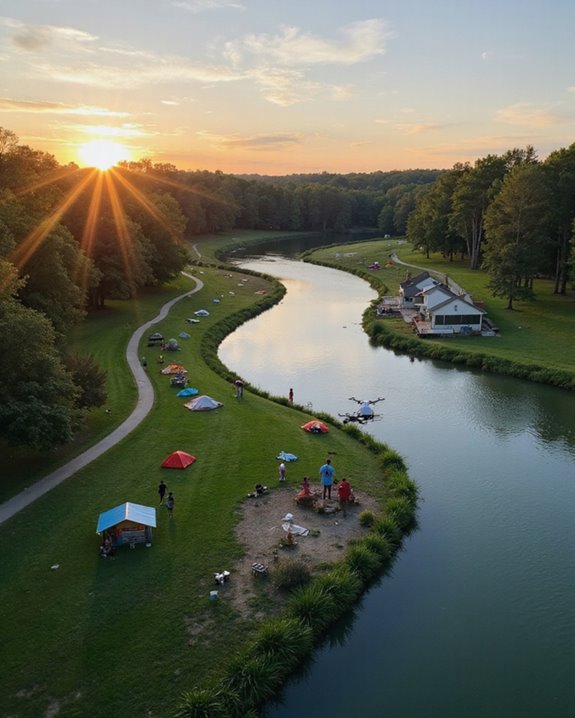
The distinction between recreational and commercial drone operations forms the foundation of all drone licensing requirements. While recreational flyers follow Part 101 rules and need only pass the TRUST test, commercial pilots must obtain a Part 107 Remote Pilot Certificate—a significant difference that reflects the varying Recreational Risks and Commercial Benefits associated with each type of flight.
Flying for fun? You’ll need to register drones over 250g and always maintain visual line of sight. But the moment you snap a photo for payment or business purposes, you’ve crossed into commercial territory! Commercial operators enjoy greater operational flexibility, including the ability to request waivers for flights over people or beyond visual line of sight. These privileges come with responsibilities, though, including age requirements (minimum 16), TSA background checks, and stricter operational limitations. Understanding the FAA certification process is essential for legal commercial drone operations.
Weight Classifications and Their Impact on Licensing
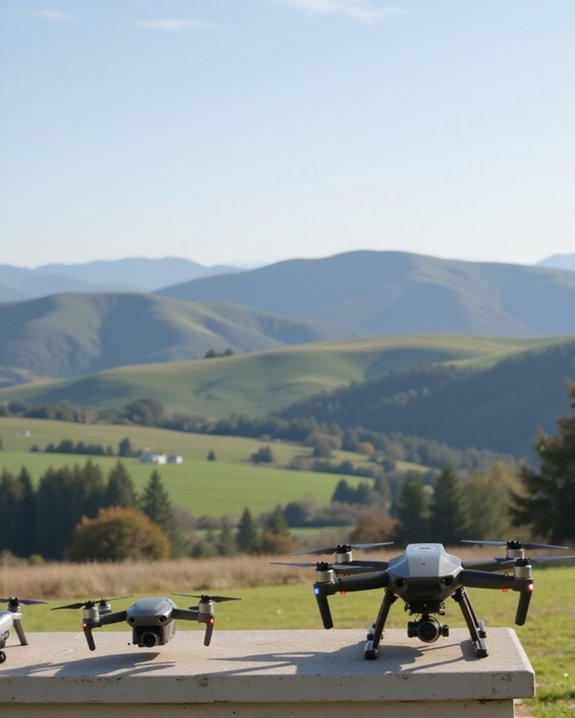
Drone weight serves as a critical factor in determining what licensing requirements apply to your unmanned aircraft. The Weight History of drone regulations has evolved dramatically, with the FAA establishing the key 250-gram threshold as a pivotal point for registration requirements. Drones under this weight used recreationally don’t require registration, while all professionally used drones fall under Part 107 regulations regardless of size!
Licensing Trends show that commercial operators face stricter requirements than hobbyists. Your sub-250 gram mini-drone might seem free from red tape for backyard fun, but the moment you snap photos for a client, you’re in commercial territory. Drones over 55 pounds enter an entirely different regulatory category, requiring special approvals. Remember, these weight classes weren’t created to complicate your flying adventures, but to keep our skies safe! Many popular models like the DJI Mini 3 weigh just under 250g, allowing users to avoid FAA registration for recreational use.
International Drone Regulations: EU and Beyond
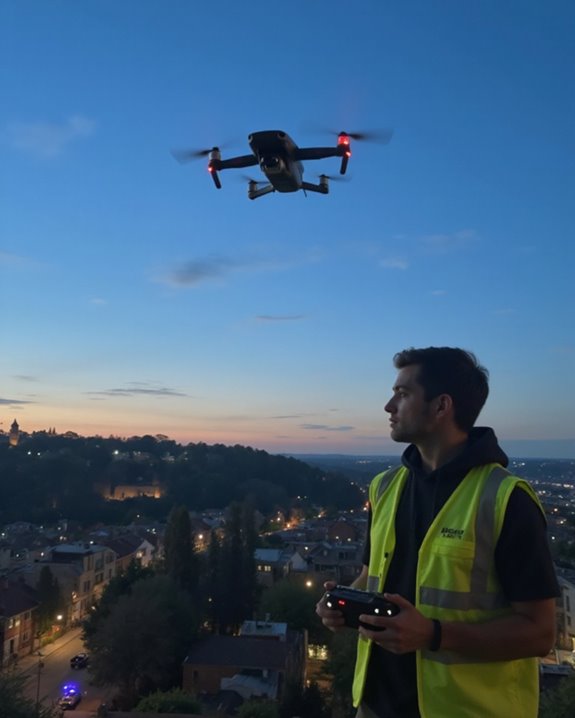
Traversing international airspace with your drone requires understanding a complex patchwork of regulations that vary dramatically across borders!
In the EU, drones must stay below 120 meters, remain in visual line of sight, and avoid crowds. Drones over 250 grams require registration and an EU license, while Remote ID broadcasting is mandatory for C1 class or higher. The EU’s categorization system (A1, A2, A3) determines where you can fly and what qualifications you need.
Global Harmonization efforts are underway between EASA and other regulatory bodies, aiming to standardize rules for easier international operations. Meanwhile, BVLOS Innovations are expanding possibilities for commercial operators in multiple countries, though with strict safety requirements. Night flying, previously restricted, is increasingly permitted with proper lighting and training. Remember, what’s legal in one country might land you in hot water in another!
State and Local Laws That Affect Drone Pilots
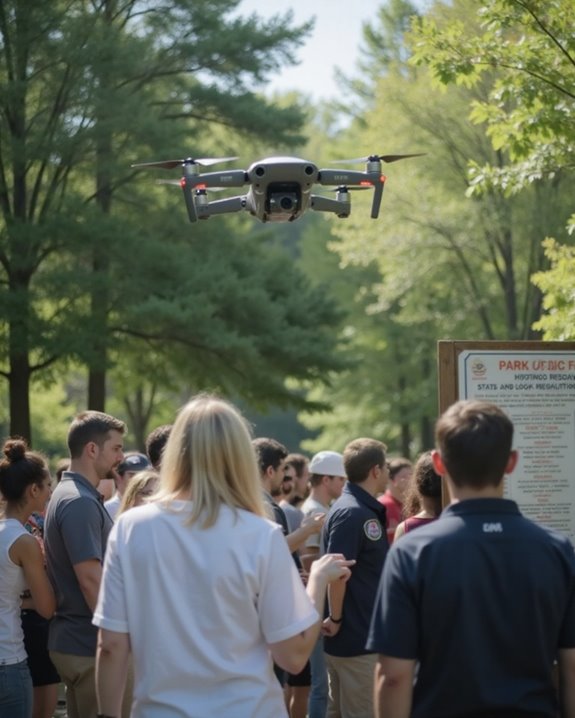
Beyond the international arena lies another maze of regulations right here in the United States, where maneuvering state and local drone laws can feel like flying through a legal obstacle course! Each state has developed its own approach to drone regulation, with varying State Penalties for non-compliance. Ohio’s H.B. 77, for instance, prohibits reckless flights that endanger people or property, while Florida’s S.B. 700 imposes specific operational boundaries.
The complexity doesn’t end there—Local Ordinances add another layer of rules to navigate. Many municipalities create their own policies for drone use in parks and public spaces, which can differ dramatically from one town to the next! Remember, violations can lead to fines or even jail time, so it’s essential to research the specific regulations in your area before takeoff.
Steps to Obtain Your Remote Pilot Certificate
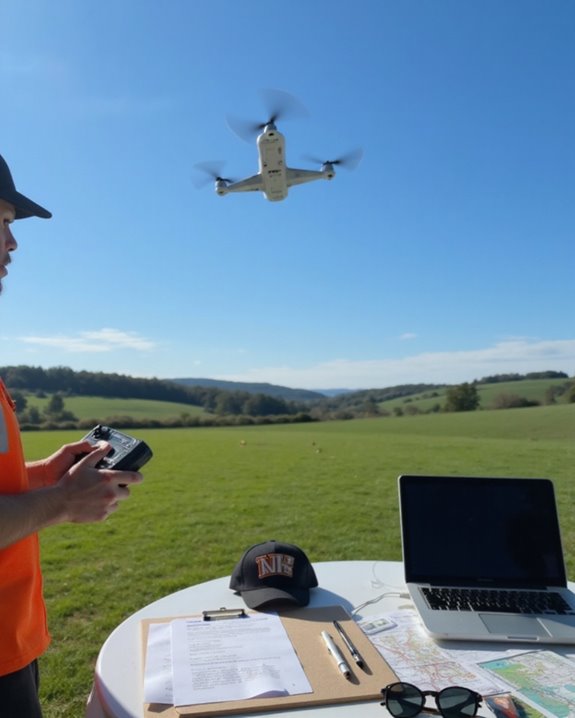
Once you’ve decided to take your drone flying to the next level, obtaining your Remote Pilot Certificate becomes your gateway to legal commercial operations! The Application Steps begin with creating an account on the FAA Safety Team website, where you’ll select “Pilot” and then “Remote Pilot” for your certification type.
Test Preparation is essential before tackling the Aeronautical Knowledge Test at an FAA-approved center. Many pilots find online training courses particularly helpful for handling topics like airspace regulations and weather patterns. Remember, you must be at least 16 years old and able to read and speak English to qualify!
After passing your test, upload your results to the IACRA system. Following a TSA background check, you’ll receive a temporary certificate while awaiting your permanent one in the mail. Ready for takeoff?
Frequently Asked Questions
How Old Must I Be to Get a Drone License?
Age limits vary by purpose: recreational drone operators of any age can take the TRUST test, while youth eligibility for commercial Part 107 certification requires individuals to be at least 16 years old.
Can I Fly a Drone After Drinking Alcohol?
The shadow of alcohol influence creates a dangerous precedent. Flying intoxicated is illegal for commercial pilots, while recreational operators face state-specific penalties. Many regions have laws prohibiting drone operation with BAC above 0.08%, risking fines and jail time.
What Insurance Requirements Exist for Drone Operators?
While no federal mandate exists, drone operators should consider various insurance types including liability and hull coverage. Premium options range from hourly to annual plans, with costs varying based on coverage needs.
Do Weather Conditions Affect My Drone License Requirements?
Through stormy skies or clear horizons, weather impacts drone operations, not licensing requirements. Remote pilots must assess visibility, cloud clearance, and temperature rules to guarantee legal flight compliance under their existing certification.
What Happens if My Drone Causes Property Damage?
Property damage caused by drones triggers legal ramifications including mandatory FAA reporting for damages over $500. Operators face potential compensation claims through civil lawsuits, requiring payment for repairs and related expenses.





